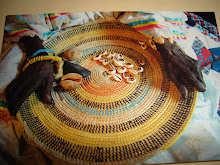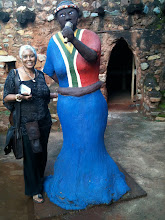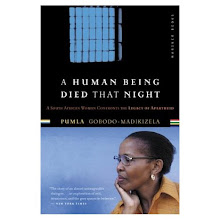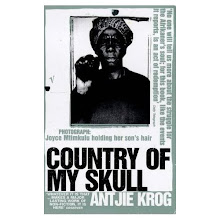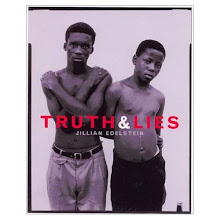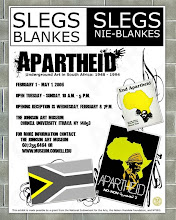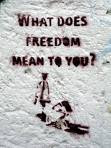




We celebrated our reunion in Johannesburg in Melville a very small vibrant community with buzzing restaurants and bars, our third traveler relating her stories of swimming in the Zambezi River, standing on slippery rocks under the Victoria falls, and feeding 30 people with one chicken. She was tucking into the Asian food and vanilla ice cream with great relish.
The next day I organized through an acquaintance who lived in Soweto and just met in Kuruman for the first time, to be picked up for a tour of Soweto. This is how it happens in South Africa in my humble experience. If I walk without fear, sensitivity for people trying to make a living and trust, I get taken care of. Personally I prefer to go with the locals and stand to have a much more of a real time that isn’t tainted by post apartheid people trying to fit into the New South Africa.
“We will make a plan” is a saying that folks use here. It means people will go out of their way to make sure that you are cared for, met at airports by strangers and carried safely to where ever you are going, oh and did mention given shelter and food. UBUNTU UBUNTU again and again. Even taxi drivers can be relied on here, called several days ahead from another town they will show up! Extraordinary. SO I have no qualms that people will be where they have promised to be, and do what they say they are going to do. A fantastic lesson if you find yourself a little flaky and unreliable and full of complaints.
Don’t get me wrong, not all things work out, due to elements, drink, drugs, poverty and a variety of other things. Yes bad things happen to not just bad people..... life I believe it is called...and if you add that to unnecessary risks, chance, fate then things occur. Truth is it can, as it can in Oakland, London, Kensington, Manhattan and other posh or not so posh places. But it is not by any means this wild and dangerous place where you have to hide away behind your locked gates with several dogs to keep you imprisoned from living your life or integrate and never go anywhere as some people have lived here since apartheid ended.
I travel with caution but not fear, trust not temptation I obey the rules of those who have lived here, black and white and so far all is good, and I don’t allow arrogance, resilience to authority, get in the way of temptation. I put my handbag or purse in the trunk of the car, as I am told to do and I can do all that and someone can still stick their hand through the window of my car to grab a $20 cell phone to sell for food for their starving kids. Is it right no.... but I cannot judge. When a local person tells me not to get out of the car, I listen !
When we live in such fear we not only keep out the bad things we keep out all the amazing things. South africa is one of the most stunningly beautiful countries you could ever imagine. It is diverse in every way. Its polarization is in your face, daily in every breath you take. It is vibrant, exciting, diverse, stunning and scary, and if you let the scary bit get you, then you will not go anywhere.
So for me to climb into a bus with 2 strange, yes, local men from Soweto who I know only from someone I met for literally a few minutes, meant that I was taking a risk, not because they were black but because they were strangers, and it wasn’t silly as I trusted the new acquaintance and I had three other people traveling with me. I noticed that some people also always try to bargain with black people about cost, not something they would do if it were a white tour operator. It’s completely absurd and degrading. Everyone is trying to make a living here.
Two men arrived in a very nice mini bus and we climbed in excited. Our first stop was to change money at the bus station in Johannesburg, a busy metro of people coming and going a very busy very black hub hub of activity, not a place to be hanging out or walking alone, as we were told later by the black taxi driver. Yes the air conditioning in the bus broke down just 30 minutes into the tour, which probably would not have happened had you paid another R400 or maybe it would...something has to break down ..right? It would not be Africa if it didn’t.
Soweto is known as the heart beat of the nation. It is a melting pot of South African Urban culture, infused with the history of the struggle against apartheid and abuzz with the energy of the city of gold. Shabeens ( local drinking establishments) heritage sites, music, arts and crafts and restaurants is the Soweto that has always been there, but now in the New South Africa and did I mention the World Cup? It has cleaned up nicely thank you, spruced, vibrant and a place of friendship. Yes it is okay to walk the streets as it is in most townships, but not many people know that you know, because they simply do not do it and along the way you will be in the heart of the most metropolitan township in the country, a most populous black urban residential area with a population close to a million.
Frankly I could not wait to step foot on its streets and smell the air that I had only heard of and seen from afar. I was struck by the grey concrete four room dwellings "the matchbox Houses” are still there, originally built for the first black migrants. The shacks are just that, one room the size of some people’s toilet and some a little bigger. I had a longing to see inside these shacks and I wondered and remembered the police riots, and the squalor I had read about in Kaffir Boy, Mark Mathabanes novel. The shacks are still there and still home to many Sowetans, and they take pride in making them home and still I hear people say, well they don’t know any better, and my heart fills and I hear, “you seem to let this really bother you” and I am speechless that these words still fall from the mouths of those in denial or is it shame, in the New South Africa. Despite the poverty, a strong sense of community has been established in the squatter camps and surrounding areas.
Soweto is a huge sprawling infrastructure of several thousand houses.
Much different from a few years ago when the Sowetan landscape consisted mostly of tin shacks and broken down houses. South Africa is the only country I believe in the world that provides some free housing. Soweto is a place of contrasts, piles of garbage alongside the newly planted grass and trees. There are the poverty stricken and the millionaires all living in the same swarming infrastructure with its own stores and gas stations. It is only in recent years that the democratic government has spearheaded moves to provide running water, provide electricity, plant trees and develop parks for the township. Despite the high unemployment I continue to see the creativity and entrepreneurship in the many traders plying their wares on the street corners. Recycling wire into elaborate toy bicycles, or animals studded with brightly colored beads, plastic bottles into beautifully painted boxes and plastic bags into strong bags! It puts the USA to shame!
Back in 1904 Klipspruit the oldest cluster of townships was established. Soweto is an Acronym for “South Western Townships” and from the start intended to be segregated. What struck me was walking into the center of Freedom Square where the freedom charter was adopted,(see previous posts) a grey concrete structure and the Soweto Hotel, also a grey concrete structure ....nothing was meant to be attractive and beautiful in Soweto when it was planned. It housed mainly black laborers, who worked in the mines away from the inner city and the famous single hostels where they lived can still be seen. More spots in inner Joburg were later reserved for white occupation, and in the 1950’s as more black neighborhoods were emptied out for white residents, Soweto became the so called dumping ground for those being relocated.....Senzenina -what have we done? Our only sin is our blackness.
Soweto’s history is rich. It became the center of campaigns that wanted to overthrow the apartheid state. Uprisings began in Soweto and included the famous student uprisings where Hector Pietersen was shot dead, in 1976 and changed the course of South African history.
Many political activists live and have lived here including Nelson and Winnie Mandela, and Desmond Tutu, their houses open as museums in the township. Oh and did I mention the township awaits the world cup with pride, its stadium is ready as it always has been, as Soweto produced the highest number of Soccer teams in the country.
The Orlando power station towers carries the largest mural painting in South Africa. And if you love graffiti and wall art some of it is spectacular. Make sure and check out the exquisite ones near the Regina Mundi church and also shown above.
First stop Nelson Mandela’s house which houses Mandela Memorabilia. It is a humble little house in Orlando West and it is where Mandela wanted to return rather than move to a more affluent area. I left my fellow travellers to wander whilst I sat with the tour organizer a whippet of a man called Mahlaba who was very efficient and looking forward to the world cup and the expected generation of business that it would bring. We sat outside at the wooden tables at the famous restaurant close by and shared a cold drink. There was a never ending buffet that served, chicken curry, tripe, sweet potatoes endless vegetables, beets, salads and malva pudding a sponge made with dates and treacle and trifle. All the yummie foods that reminded me of my families cooking. It was constantly busy, friendly, buzzing and vibrant. When the girls returned we ate as much as we wanted for 85 rand, about $11. After our sumptuous lunch we hopped back into the small bus, next stop the Hectar Pietersen Museum dedicated to the first child tragically shot in the Soweto riots, when the School children came out to protest about being forced to learn Afrikaans as part of their curricula. See past blog posts. The police opened fire on a peaceful group of children
The tour coordinator suggested 15 minutes and after my friends entered, and before I followed them in, I sat next to him on the stone wall, across from the vendors that sold the local arts and crafts. My heart was surprisingly full with emotion, as we had driven through the township, I spoke gently.
Mahlaba, it’s very important that those coming to our country learn the history of our people and that you participate in encouraging folks to spend as much time as they need in the museum, so you become a part of telling the story, 15 minutes is not enough. He listened intently and I saw a sadness descend. You are right maam he said. No need to call me maam, you are my brother, let’s work together to tell the story. I will bring you people and you honor your people by being patient. We shook hands on it, in the old African way.
The museum is excellent, small, but a beautiful honoring and portrayal of the events leading up to this historical event, it follows a history that is key and essential for those wanting to know South Africa. There are benches across from videos, text, newspaper articles or photos where at times one wants to sit and integrate and process the deep sadness that overtakes you as you read and look at the images on the walls. I saw tears brimming unashamedly as people’s hearts suddenly softened. It is not a museum to be rushed. Threaded through the sadness comes inspiration, appreciation for the struggle of Apartheid, pride and empowerment for the people’s courage and then for me an overwhelming deep love for my people.
After that museum we were taken to the Regina Mundi church where last year the Vukani Mawethu choir that I sang in had the honor of singing alongside Johannesburg church choirs, their tones and harmony filling the vast church leaving us quite speechless. Regina Mundi Church became the home to numerous anti -apartheid organizations and hosted the funerals of scores of political activists.
It is a spiritual haven for thousands of Sowetans and visitors and is known for its role in the townships history of resistance against apartheid. It is here that police stormed through the doors firing at fleeing students, where many were injured and to this day a statue of Christ stands his arms blown off by gun fire from the out of control riot police. Rgeina Mundi means Queen of the World and it offered protection to those in the struggle for freedom and has also been called “Church of the Nation”
The church became a world-wide symbol of the determination of our people to free themselves," Nelson Mandela. The truth and reconciliation commission hearings were held in the church from 1995 -1998 presided over by Archbishop Tutu.
"The church is an eye. It must see to it that justice is done."
The church is a historical place that despite the massacre that occurred, holds an uplifting energy. The Black Madonna and child is a masterpiece in oils, the high beamed ceilings calling for it to take its place on that wall space, and overlook all children and the swelling congregation sometimes up to 5000.
Onto Walter Sisulu’s grave where we walked amongst segregated grave yards, black without headstones, Asian, Colored and Jewish. I asked Mahlaba if we could sing the national anthem, he was surprised that I knew it and that I sang in Zulu. We sang out together not solemnly but with gusto and verve for the new South Africa, right there in honor of those who died in the struggle of Apartheid.






